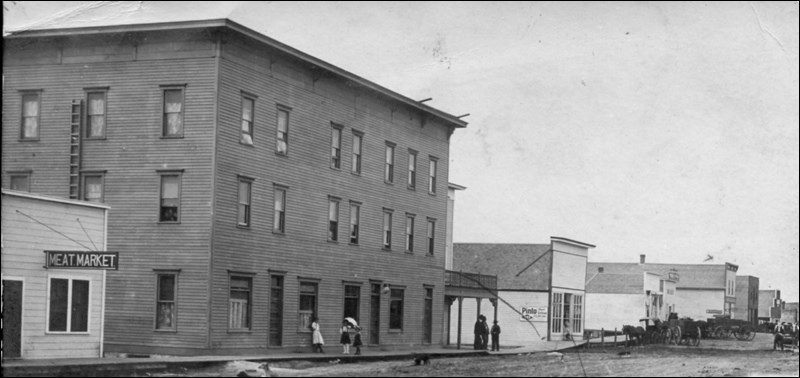Six weeks after purchasing the hotel at Macoun and getting his family settled there, Carl Hochhaus left town to see to matters on his homestead in Alberta. He could never have imagined that when he returned home, he would find his hotel a smoldering mass of debris covering the remains of many dead, including his wife Gertrude and 23-year-old daughter Emma.
On April 20, 1914, one of the most tragic hotel fires in Saskatchewan’s history occurred at Macoun, located 28 kilometres northwest of Estevan. Eleven people (some accounts say thirteen) lost their lives as a result of the disaster and many more were injured, including three Hochhaus children.
At lunchtime on that fateful day, 30 people were inside the Macoun Hotel. Some were Hochhaus family members, some were staff members, others were hotel guests. Many were sitting down for lunch, and the hotel dining room was full.
James Towey, a 10-year-old witness of the explosion, provides his account of the event in Plowshares to Pumpjacks: R.M. of Cymri: Macoun, Midale, Halbrite, (1984). Shortly after noon, Towey recounts, Carl Hochhaus Jr. smelled gas and decided to go down to the basement to investigate the gas light plant. “He had a lighted cigar in his mouth as he descended the stairs and opened the door to the basement,” Towey writes. “Immediately there was an explosion which lifted the entire structure approximately thirty feet in the air, then the building dropped back down into the basement.”
Carl was blown several feet through a doorway on to the street and survived with only a few bruises, singed hair and eyebrows. Everyone caught in the conflagration was injured, perished in the fire, or died later as a result of their injuries.
The hotel’s dining room was located directly above an acetylene light plant in the basement. The explosion caused the entire dining room to collapse into the cellar below. Wreckage from the walls and floors above fell on top of the diners and then caught fire. All of the people who were in the dining room at the time of the explosion were killed.
In addition to the two Hochhaus family members, those killed in the Macoun hotel explosion were: four telephone workers, Daniel Egan (Moose Jaw), Harold George Clark (Estevan), Thomas Drake (Manitoba), and Peter Joyner (Estevan); Joseph E. Grant, a carpenter (Macoun); James Dunger, a grain buyer (Manitoba); and three members of the hotel staff, Clifford VanDer, hotel clerk, Ferdinand Schmidt, hotel bartender, and Stella Peterson, the hotel cook who died in Winnipeg General Hospital on June 16 after weeks of suffering.
The most talked about story of the event was, according to the Regina Leader-Post, the “miraculous escape” of Hochhaus’ youngest son, Bernard. The eight-year-old was playing with his dog, a collie named Bismarck, in the lobby of the hotel when the explosion catapulted the two right out the door. Covered by debris, the collie dug its way out but would not leave without little Bernard. “That the boy did not perish also,” the paper wrote on April 23, “is attributed by everyone to the dog.”
The day after the explosion, throngs of curious people travelled to Macoun. The Leader-Post reported that onlookers “formed a moving circle around the charred ruins of the wrecked building, watching silently the men of the Mounted Police … seeking those who were lost in the holocaust.” Most remains were charred beyond recognition.
Small acetylene gas plants were the best lighting option in Saskatchewan in places where electric light was not yet available. After the Macoun disaster, there were calls for laws requiring that gas plants be housed in separate buildings a safe distance away from inhabited buildings. “One acetylene gas plant to one frame hotel equals one death trap,” the Saskatoon Daily Star stated on April 24. The arrival of electricity in villages and towns during the 1920s, however, spelled the end of gas lighting in the province.




